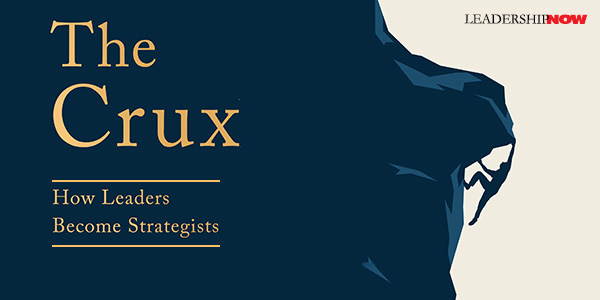 |
 |
05.09.22

The Crux: How Leaders Become Strategists
THE CRUX of the matter is a phrase that has been around for over 200 years. Richard Rumelt recalls climbers in France calling the boulders they climb “problems,” with the toughest part of the problem referred to as “the crux.” Climbers will often look for a challenge that has the greatest reward and whose crux they believe they can solve. In The Crux, Rumelt uses this as a metaphor for life. We all face problems, and finding the crux is the secret sauce where we “can gain the most by designing, discovering, or finding a way to move through and past it.” Rumelt uses the term crux to describe a three-part strategic skill: The first part is judgment about which issues are truly important and which are secondary. The second part is judgment about the difficulties of dealing with those issues. And the third part is the ability to focus, to avoid spreading resources too thinly, not trying to do everything at once. The combination of these three parts lead to a focus on the crux—the most important part of a set of challenges that is addressable, having a good chance of being solved by coherent action. We often get off to a bad start by not understanding what a strategy is. “There is a widespread misconception that a business strategy is some sort of long-range sketch of a desired destination. I encourage you to think of strategy as a journey through, over, and around a sequence of challenges.” To have a single unchanging strategy that spans through challenges “reduces the concept to a slogan or motto, like ‘Be the best.’ Strategy is problem-solving, and it is best expressed relative to a particular challenge.” Strategy is for problem-solving, but to do that, you need to get to the crux of the problem. “Don’t start with goals—start by understanding the challenge and finding its crux.” The concept of a crux narrows attention to a critical issue. A strategy is a mix of policy and action designed to overcome a significant challenge. The art of strategy is in defining a crux that can be mastered and in seeing or designing a way through it. Strategy is an exercise in power because it always involves a shift in power and resources. When faced with a number of challenges, we tend to deliver incoherent goals—actions that contradict each other. They may sound like nice goals designed to please but are incoherent and therefore unattainable. We get nowhere. (And this sums up our political gridlock.) One sees how coherence is easily lost. The cost of coherence is saying no to many interests with reasonable values and arguments. A strategist tries to not be a politician. The art of compromise and building the big tent that everyone can shelter under is not that of the strategist. Rather, it is coherence aimed at the crux of the problem. In other words, actions should not conflict with one another. For example: Don’t base your competitive edge on continuing development but then cut R&D to make your numbers. After Rumelt goes through a series of business problems that give birth to his concept of the crux as it relates to strategy, he then dispels some myths and explains how we get to the crux. Getting to the crux of the issue is harder than one might think. We are too often stuck in our assumptions. Often it requires a reframing, a new analogy, or a reanalysis of data in ways that we have not previously considered. Organizational issues “can be resolved successfully using the principles of crux-strategy problem-solving diagnosis, reduction to a crux, performance concepts, and coherent action.” You don’t want to start with goals. You want to start with challenges. “A collection of goals or metrics is not a strategy. A strategy is a reasoned argument about the forces at work in a situation and how to deal with them.” Further, “Strategy work defines the goals and objectives to be sought. Good strategy work begins with recognizing a challenge and in understanding the difficulties in overcoming it. Good strategy work produces policies, actions, and objectives.” About mission statements, Rumelt says, “If you accept that strategy is a form of problem-solving, that it is a journey, and that it is a response to challenges, then mission statements are not helpful in strategy work. They are a waste of time and effort.” Financial goals, mission statements, and quarterly earnings become distractions when strategy work. Rumelt walks us through a crux defining, strategy creating process, which he calls the Strategy Foundry. It is an intense challenge-based discussion to get to the crux that will form the basis of the strategy. It is not goal setting or budgeting. By starting with the challenge, the group becomes responsible for designing a response rather than choosing among plans already advanced by members or others, or just filling in the blanks for a longer-term budget. Each story in The Crux will make you rethink strategy—what it is and is not and how it is created. The principle of the crux is also a good life lesson. Finding the crux will help you determine the appropriate response to a given set of circumstances. 
Posted by Michael McKinney at 10:31 AM
|
BUILD YOUR KNOWLEDGE
 

How to Do Your Start-Up Right STRAIGHT TALK FOR START-UPS 
Grow Your Leadership Skills NEW AND UPCOMING LEADERSHIP BOOKS 
Leadership Minute BITE-SIZE CONCEPTS YOU CAN CHEW ON 
Classic Leadership Books BOOKS TO READ BEFORE YOU LEAD |